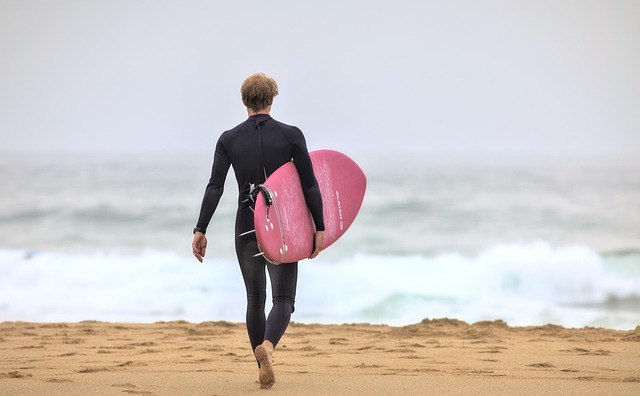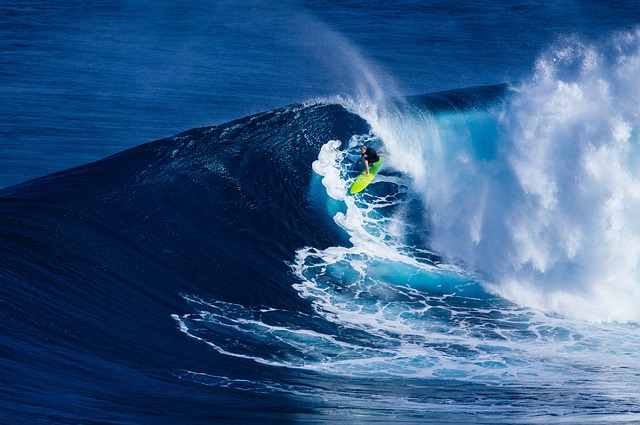For a surfboard designed for newcomers, fin design is crucial. Single fins offer classic stability ideal for beginners learning wave-riding, while multiple fins (tri-fins or quad-fins) enhance maneuverability and speed favored by advanced surfers. A single fin setup provides enhanced stability, predictability, and natural experience for novices, fostering confidence and skill development. Advanced riders may opt for multi-fin configurations for increased speed and maneuverability based on their desired surfing style and skill level. Regular fin maintenance, including inspections and adjustments, ensures an improved surfing experience.
For surfboard enthusiasts, understanding the intricacies of fin design can significantly enhance performance. This article explores the fundamental difference between single and multiple fins, catering specifically to beginners in the world of surfing. We break down the advantages and benefits of each setup, offering insights into control, maneuverability, and style. Whether you’re just starting or looking to refine your surfboard for beginners, this guide provides essential tips on choosing and maintaining the perfect fin setup.
Understanding Surfboard Design: The Role of Fins

For a surfboard for beginners, fin design is a crucial component to grasp. Fins, whether single or multiple, play a pivotal role in directing and controlling the board’s movement through the water. In essence, they act as the board’s ‘tail’ and are responsible for stability, maneuverability, and overall performance.
Single fins offer a classic setup that’s straightforward and reliable. They provide excellent stability and predictability, making them ideal for beginners learning to catch waves. Multiple fins, on the other hand, come in various configurations like tri-fins or quad-fins, offering enhanced maneuverability and speed. These setups are popular among intermediate to advanced surfers looking to carve tight turns and achieve higher speeds across different wave conditions.
Types of Fins: Single vs. Multiple

When choosing a surfboard, one of the primary considerations is the fin setup: single or multiple fins. For surfboard for beginners, single fins are often recommended due to their stability and ease of paddling. A single fin setup provides excellent directional control and is less prone to catching on waves, making it ideal for learning how to catch waves consistently. The simplicity of a single fin also reduces the maintenance required, as you won’t need to worry about adjusting multiple fins.
Multiple fin setups, typically featuring twin fins or tri-fins, offer enhanced maneuverability and are popular among experienced surfers. Twin fins provide excellent up-and-down stability while allowing for tight turns and quick changes in direction. Tri-fins, with their three fins, offer even greater stability and speed across the face of a wave. While these setups might be more complex to master, they offer advanced surfers more control and versatility in various surfing conditions.
Advantages of Using a Single Fin for Beginners

For surfboard for beginners, opting for a single fin can offer several advantages. This setup provides enhanced stability and predictability in the water, making it easier to learn and master basic surfing techniques like paddling, catching waves, and standing up. The simplicity of a single fin allows beginners to focus on improving their balance and timing without being overwhelmed by multiple fins that can create instability.
Using a single fin also promotes a more natural surfing experience. By relying on one fin, surfers develop a stronger connection with their board and the ocean, fostering a deeper understanding of wave dynamics. This familiarity is crucial for beginners who are still developing their skills, as it encourages them to experiment, adapt, and ultimately become more confident in their abilities on the surfboard.
Benefits of Multiple Fins: Control and Maneuverability

For surfboard enthusiasts, especially those just starting their journey in the waves, choosing between single and multiple fins can significantly impact their overall experience. When it comes to control and maneuverability, multiple fins on a surfboard offer distinct advantages.
With more fins, surfboards provide enhanced stability, allowing beginners to catch waves with ease. This added stability enables them to focus on learning fundamental skills like balancing and turning without worrying about losing traction in the water. The extra fins also facilitate quicker changes in direction, making it simpler for newcomers to navigate and carve through the waves, fostering a more enjoyable and accessible surfing experience.
Choosing the Right Fin Setup for Your Style

When it comes to choosing a fin setup, whether single or multiple, it’s all about finding the right balance for your unique surfing style and skill level. For surfboard beginners, a single fin is often recommended as it provides stability and predictability in the water. This setup is simpler and easier to control, allowing newcomers to focus on mastering the basics of paddling, catching waves, and performing turns without worrying about complicated adjustments or interactions between multiple fins.
As surfers gain experience and develop their techniques, they might transition to a multi-fin setup, which offers enhanced maneuverability and speed. These setups are particularly popular among advanced surfers who prefer more dynamic and agile performances. Whether you’re carving smooth turns or performing radical maneuvers, the right fin count and configuration can significantly impact your surfing experience, making it crucial to consider your style and aspirations when selecting a surfboard with the appropriate fin setup.
Tips for Maintaining and Adjusting Your Surfboard Fins

For a surfboard for beginners, proper fin maintenance is key to enhancing your surfing experience and performance in the water. Regularly inspect your fins for any signs of damage or wear and tear. Replace them promptly if they appear frayed, broken, or discolored, as worn-out fins can negatively impact your board’s stability and maneuverability. Keep an eye on the fin’s alignment, ensuring they are centered and securely fastened to the board. Adjustments might be necessary as your surfing skills progress; experiment with different fin positions to find what works best for various surf conditions.
Consider using a fin key to tighten or loosen them, allowing you to tweak your setup effortlessly. Remember, the ideal fin configuration depends on personal preference and water conditions. For instance, larger fins offer more stability but may reduce speed, while smaller fins provide enhanced speed and maneuverability. As a beginner, start with standard fin sizes and types recommended for your board, then gradually experiment to find what suits your unique style and allows you to catch more waves.
